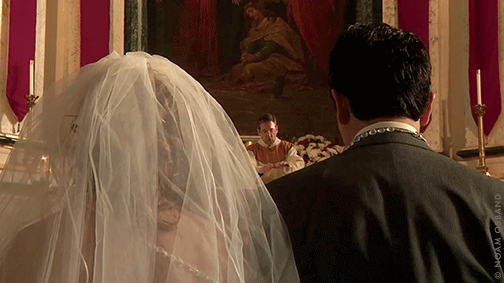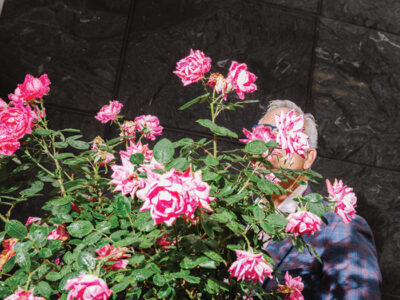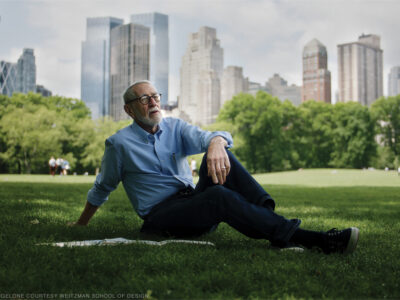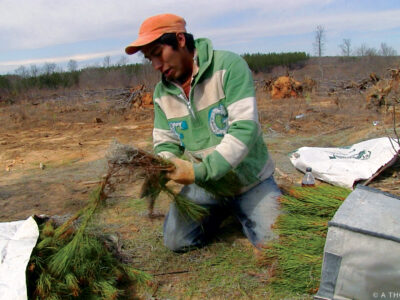
If aspiring filmmaker Noam Osband Gr’15 had pitched a Hollywood studio on the real-life story of his role in reshaping the parameters of graduate education at Penn, it might have been rejected as not believable enough.
Consider the plot line: A first-year anthropology student with a hankering to make movies raises the money to buy state-of-the-art equipment by winning on Jeopardy. A chance conversation with a faculty adviser leads to his first documentary—which airs this February on public TV. And most importantly, his determination to merge filmmaking with his academic work accelerates a conversation that has now placed the University on the cutting edge of re-inventing graduate research for the 21st century.
Osband is on track, either this spring or next, to become the first student in Penn’s history to submit a film—his in-depth study of Mexican migrants working as tree planters in the American forest industry—as a doctoral dissertation. And in the process, according to several faculty members—including his close adviser John Jackson, dean of the School of Social Policy & Practice—he has also sped up the University’s wider efforts to consider not only film but other contemporary media as the potential final product of academic research, where lengthy written papers have long been the norm.
“He was the first person to really force us to think about it,” says Jackson about the idea of accepting a full-length movie as a degree dissertation, “but he won’t be the last.” Jackson had already helped launch the campus group CAMRAin 2012, an interdisciplinary effort by researchers and educators committed to experimental media-making.
One of the first fruits of this collaboration will hit the airways in February when WHYY, the PBS station in Philadelphia, airs a condensed version of Adelante, a documentary about an historically Irish-American Roman Catholic parish in the faded riverside suburb of Norristown that has adopted the city’s fast-growing population of Mexican immigrants. Although the film, directed by Osband, is not directly a part of his anthropology research, it did arise from the hothouse of Penn’s new-media environment. It also showcases Osband’s fascination with the struggles of those who travel far from home to make a new life in America.
“If they do this job,” Osband says of the tree planters that he’s been filming more recently, many of whom hail from the impoverished Mexican state of Oaxaca, “that means leaving their homes, even though they often have a wife and kids, and hoping they can save enough cash to move back eventually.” He says he wanted to focus his anthropology research on investigating why Mexicans are so willing to perform this back-breaking work that few Americans will take on, even in a time of high US unemployment, and he was determined to use film as the medium to both gather their stories and relate it to others.
It may be hard to believe that one 34-year-old anthropology student could play such a catalytic role in changing ideas about graduate research at Penn. But it’s not surprising to those who’ve worked with Osband, a wavy-haired and bespectacled bundle of energy who colleagues generally describe with one word: determined.
“Noam is Noam,” says Cate Rhodes, a joint PhD candidate in cultural anthropology and at the Graduate School of Education who worked closely with Osband as associate producer of Adelante. She praises his lack of pretension in dealing with everyone from Ivy League professors to migrant farm workers.
“People think he’s genuine,” she says. “They think he’s crazy, but they appreciate his genuineness.”
Osband credits his offbeat approach to life partly to his somewhat insular childhood in Brookline, Massachusetts, just outside of Boston. He grew up surrounded by Orthodox Jews, both at home and at the religious schools he attended. That sheltered upbringing, he says, increased his curiosity about assimilation in America and about people who were different from him. Before enrolling at Harvard as an undergraduate, he recalls, the only non-Jews he’d met were the janitors at his high school, and he went out of his way to talk to them.
Along with insularity came that absence of pretension. Over the years, Osband has made a few extra dollars and drawn more than his share of gawks as a ukulele-toting street performer. The Daily Pennsylvanian dubbed him “Master Uke” after recording the grad student playing Tiny Tim’s favorite instrument outside Huntsman Hall on a nice day, but Osband says his career highlight came when two British bobbies in Oxford recalled and requested his rendition of Madonna’s “Material Girl.”
Osband is also not shy about his knowledge—which would come to play a supporting role in advancing his film career. A fan of Jeopardy since childhood, when a grandfather called him up every night to quiz him on the “Final Jeopardy” clue, Osband tried out for the show during his first year at Penn. He became a one-time champion. He won $30,000 and endured the embarrassment of Alex Trebek asking him on TV about the time his mom and grandmother watched him in Harvard’s famous pre-finals nude run.
He wasn’t done. Two years later, Osband tried out on a whim for Who Wants To Be a Millionaire, got called again, and this time pocketed $250,000. Most of his prize money has stayed in the bank, but Osband did use some of his Jeopardy winnings to buy high-tech equipment to indulge his growing passion for filmmaking.
“I wanted a job where I could ask strangers questions,” says Osband, who pondered his career options while he earned master’s degrees in cultural anthropology from the University of Oxford and from the Bread Loaf School of English at Middlebury. When he entered the PhD program at Penn, Osband was drawn in part by the opportunity to simultaneously study film at the School of Design. He was mindful that motion pictures have been a tool in cultural anthropology since the early 20th century, but he wanted to make film even more of a focal point of his studies.
“It became clear that filmmaking was a way where I could combine the intellectual rigor of anthropology courses with my own creative needs and desires to make beautiful things,” he says.
Osband proposed his filmed dissertation not long after he began the program, and found likeminded allies on the faculty. One was Stanton Wortham, the Judy & Howard Berkowitz Professor and associate dean for academic affairs in the Graduate School of Education, who had a research grant to work with the fast-growing Latino community in Norristown, the county seat of Montgomery County. Local immigrant activists wanted to create a film to persuade Spanish-speaking parents to get more involved in schools; Wortham and a student shot the raw footage, but still needed an editor when Osband walked into his office for an unrelated appointment.
Not only did Osband agree to edit the film, but they discussed making a broader documentary on the city’s mostly Mexican immigrant population. Wortham introduced him to Father William Murphy, who at the time was a priest at St. Patrick’s Parish, where many of the new arrivals worshipped. Osband soon began shooting footage.
One of the first scenes he filmed was a planning session for a group wedding of Mexican congregants, many of whom had delayed the event in the hope that they could eventually celebrate it with parents and families still in Mexico. One of the women, Maria, who’d already had two children with her fiancé, Hector, brought the meeting to a halt when she asked Father Murphy if she could wear white to the wedding. Her broad yet sheepish smile when the priest answered yes, captured by Osband’s camera, became the inspiration for Adelante, Spanish for “forward.”
The finished documentary weaves the tale of Hector and Maria’s pending nuptials through a mosaic of rituals and fellowship that bind the older Irish-American worshippers to the Mexican newcomers, and it serves as a poignant reminder than Latinos are just the newest wave in a centuries-old tradition.
Adelante also accelerated efforts on the Penn campus to evaluate how best to integrate film and newer media into academic work. In addition to the activities of CAMRA—which seeks to inspire multimedia collaborations between ethnographers, artists, scholars, and educators—Wortham worked more closely with Jackson and Amitanshu Das, a seasoned filmmaker who’s a senior fellow in the Graduate School of Education. The trio launched a course called “Documentary, Ethnography, and Research: Communicating Scholarship through Film/Video,” which helps graduate students develop new ways for using film to both gather data and present findings.
The bigger question is to what extent film and other media can replace the written paper, the lingua franca of academia for centuries. Wortham says he sees what he calls “a generational shift,” enabled by new technology that makes shooting video and editing it both easier and less expensive.
But Jackson, who played a key role in approving Osband’s current film project as his doctoral dissertation (along with a small written component), says that the broader effort to include multimedia means overcoming years of entrenched academic thinking. He says he was told early in his career that “to be a scholar and be taken seriously, you still have to provide written work.” Today academics are debating standards for how non-written media should fit into long-entrenched processes like tenure evaluation.
As for Osband, he’s still hard at work editing his dissertation, but he’s moved to Brooklyn, to be closer to New York’s thriving film community. He’s already thinking ahead to the next plot twist. “Now I want to be a filmmaker,” he says, “and New York is a great place to meet other filmmakers.”
—Will Bunch




